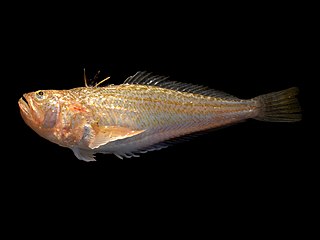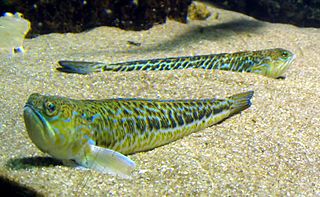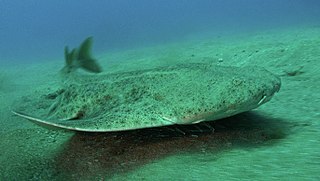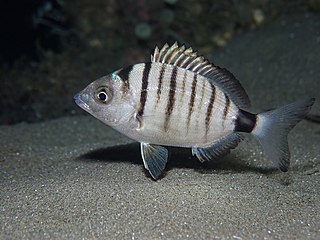
Weevers are nine extant species of ray-finned fishes of the family Trachinidae in the order Perciformes, part of the wider clade Percomorpha. They are long, mainly brown in color, and have venomous spines on their first dorsal fin and gills. During the day, weevers bury themselves in sand, just showing their eyes, and snatch prey as it comes past, which consists of shrimp and small fish.

Cymothoa exigua, or the tongue-eating louse, is a parasitic isopod of the family Cymothoidae. It enters a fish through the gills. The female attaches to the tongue, while the male attaches to the gill arches beneath and behind the female. Females are 8–29 mm (0.3–1.1 in) long and 4–14 mm (0.16–0.55 in) wide. Males are about 7.5–15 mm (0.3–0.6 in) long and 3–7 mm (0.12–0.28 in) wide. The parasite severs the blood vessels in the fish's tongue, causing the tongue to fall off. It then attaches itself to the remaining stub of tongue and the parasite itself effectively serves as the fish's new "tongue".

The Lessepsian migration is the migration of marine species along the Suez Canal, usually from the Red Sea to the Mediterranean Sea, and more rarely in the opposite direction. When the canal was completed in 1869, fish, crustaceans, mollusks, and other marine animals and plants were exposed to an artificial passage between the two naturally separate bodies of water, and cross-contamination was made possible between formerly isolated ecosystems. The phenomenon is still occurring today. It is named after Ferdinand de Lesseps, the French diplomat in charge of the canal's construction. The term was coined by Francis Dov Por in his 1978 book.

The lesser weever is a venomous weever of the family Trachinidae, in the order Perciformes, and the class Actinopterygii. It is generally found on the sandy sea beds of the open sea, near the shore. Lesser weevers may sting swimmers badly if disturbed in the water, and fishermen when they clean their fishing nets.

The greater weever is a benthic and demersal venomous marine fish of the family Trachinidae. The greater weever is widely distributed along the eastern Atlantic coastline from Norway to Morocco, extending to the Mediterranean, Aegean and Black Seas. Trachinus draco has been shown to occur in depths ranging from shallow water up to -150 meters where it inhabits mostly muddy or sandy grounds. Trachinus draco is mostly and notoriously known for its venomous spines that can inflict serious injuries on humans through accidental stinging. Because of these spines and its potent venom it is classified as one of the most venomous fishes in the Mediterranean. The name "weever" is thought to originate from the Anglo-Saxon word "wivre" which translates as "viper".

The Portuguese dogfish or Portuguese shark, is a species of sleeper shark of the family Somniosidae. This globally distributed species has been reported down to a depth of 3,675 m (12,057 ft), making it the deepest-living shark known. It inhabits lower continental slopes and abyssal plains, usually staying near the bottom. Stocky and dark brown in color, the Portuguese dogfish can be distinguished from similar-looking species by the small spines in front of its dorsal fins. Its dermal denticles are also unusual, resembling the scales of a bony fish. This species typically reaches 0.9–1 m (3.0–3.3 ft) in length; sharks in the Mediterranean Sea are much smaller and have distinct depth and food preferences.

Squatina squatina, the angelshark or monkfish, is a species of shark in the family Squatinidae, that were once widespread in the coastal waters of the northeastern Atlantic Ocean. Well-adapted for camouflaging itself on the sea floor, the angelshark has a flattened form with enlarged pectoral and pelvic fins, giving it a superficial resemblance to a ray. This species can be identified by its broad and stout body, conical barbels, thornless back, and grayish or brownish dorsal coloration with a pattern of numerous small light and dark markings. It measures up to 2.4 m (7.9 ft) long.

The comber is a species of marine ray-finned fish from the family Serranidae, the sea basses. It is widely distributed in the eastern North and South Atlantic Oceans and into the southwestern Indian Ocean. It is caught for food and fishmeal in some parts of its range.

The painted comber is a species of marine ray-finned fish, a sea bass from the subfamily Serraninae, classified as part of the family Serranidae which includes the groupers and anthias. It is found in the eastern Atlantic Ocean, the Mediterranean Sea, and the Black Sea. Confusingly, a synonym of this species is Perca marina, but that name has incorrectly been used for a separate species, the rose fish.

The red porgy, also known as the common seabream or Couch's bream, is a species of marine ray-finned fish in the family Sparidae. It is found in shallow waters on either side of the Atlantic Ocean, being present on the western coast of Europe and the Mediterranean Sea as well as the eastern coasts of North and South America and the Caribbean Sea. It feeds on or near the seabed and most individuals start life as females and later change sex to males.

The Cymothoidae are a family of isopods in the suborder Cymothoida found in both marine and freshwater environments. Cymoithoids are ectoparasites, usually of fish, and they include the bizarre "tongue-biter", which attaches to a fish's tongue, causing it to atrophy, and replaces the tongue with its own body. Ceratothoa oestroides is one of the most devastating ectoparasites in Mediterranean aquaculture. Around 40 genera and more than 380 species of cymothoid are recognised. Species of the Cymothoidae are generally found in warmer waters and rarely in the cool and cold climates.
In the 10th edition of Systema Naturae, Carl Linnaeus described the Pisces as:
Always inhabiting the waters; are swift in their motion and voracious in their appetites. They breathe by means of gills, which are generally united by a bony arch; swim by means of radiate fins, and are mostly covered over with cartilaginous scales. Besides the parts they have in common with other animals, they are furnished with a nictitant membrane, and most of them with a swim-bladder, by the contraction or dilatation of which, they can raise or sink themselves in their element at pleasure.

Diplodus sargus, the sargo, common white seabream, or white seabream is a species of marine ray-finned fish belonging to the family Sparidae, which includes the seabreams and porgies. This fish is found in the eastern Atlantic Ocean and in the Mediterranean Sea. It is a target species for commercial fisheries and is grown in aquaculture. D. sargussensu lato was formerly thought to be a widespread species in the eastern Atlantic and western Indian Oceans but the taxa outside of D, sargussensu stricto are now recognised as valid species and are part of the D. sargus species complex.

Aega psora is a species of isopod crustacean that parasitises a number of fish species in the North Atlantic. It is a serious ectoparasite of larger species of fish, particularly when they are injured.

Ceratothoa oestroides is a crustacean isopod, obligate ectoparasite of marine fish that dwells in the buccal cavity. It is the causative agent of various pathologies including tissue damage at the parasitisation site (tongue), growth defects, decrease in mean host weight and size and increases mortalities in farmed and wild fish populations. It has been recorded in six different fish families: Sparidae, Carangidae, Clupeidae, Maenidae, Scorpenidae, and Mugilidae.

Ceratothoais a genus of isopod ectoparasites of teleost fish, first described by James Dwight Dana in 1852. Infection by Ceratothoa can cause anaemia, lesions, growth retardation, emaciation, and mortality in their fish hosts.

Diplodus puntazzo, the sharpsnout seabream, sheephead bream or puntazzo, is a species of marine ray-finned fish belonging to the family Sparidae, which includes the seabreams and porgies. This species is found in the Eastern Atlantic and the Mediterranean and Black Seas. This omnivorous fish is an important species for aquaculture and fisheries, despite the flesh not being highly esteemed.

Natatolana neglecta is a species of crustacean in the family Cirolanidae, and was first described by Hans Jacob Hansen in 1890 as Cirolana neglecta, It was redescribed as Natatolana neglecta by Stephen Keable and Niel L. Bruce in 1997.

Diplodus argenteus, the silver porgy, is an ocean-going species of sparid fish (seabream/porgies). It is also called the South American silver porgy and the white bream in Uruguay, plus the silver seabream and the sargo, though the latter three names are also used for other fish species as well.

















